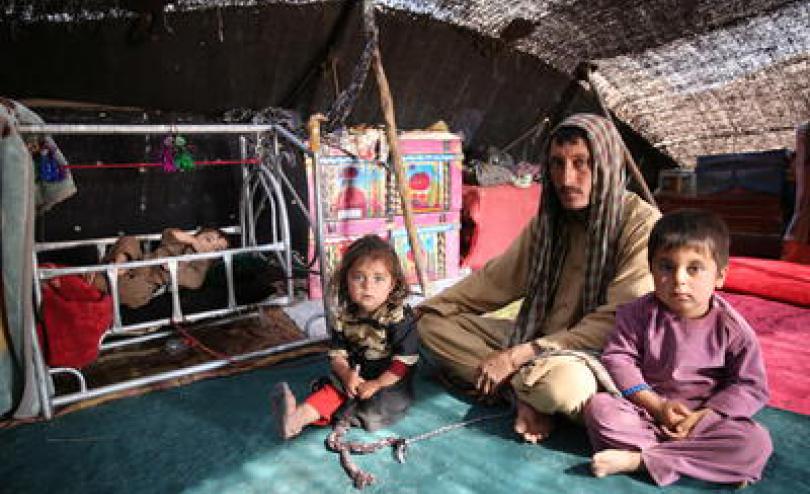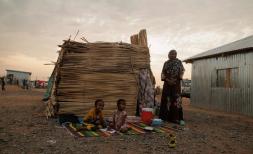ONE IN THREE CHILDREN IN AFGHANISTAN TO ENTER 2024 FACING CRISIS LEVELS OF HUNGER

Edris* (30) and his children, affected by the recent earthquake in Herat. (Photo Credit: Atabek Khadim / Save the Children)
KABUL, 14 December 2023– Almost 8 million children in Afghanistan – or one in three - will enter the new year facing crisis levels of hunger as increasingly freezing conditions threaten communities already reeling from drought, earthquakes, and economic hardship, said Save the Children. New figures[i] released today by the IPC, the global hunger monitoring system, predict an increase in the number of people experiencing crisis or emergency levels of hunger in Afghanistan during the winter months, although the situation has improved compared with the same period last year.
An estimated 15.8 million people – more than a third of the country’s population – are expected to experience acute food insecurity before March 2024. Almost half of those - or 7.8 million - are children[ii]. During the winter, employment opportunities are reduced, and food and fuel prices usually rise, according to the IPC (Integrated Food Security Phase Classification).
Afghanistan is also having to cope with rising numbers of Afghans returning from Pakistan and Iran. About 460,000 people[iii] have crossed back into Afghanistan since September after Pakistan told undocumented foreigners to leave, with an additional 345,000 returning from Iran, according to the de facto authorities in Afghanistan[iv].
Afghanistan faced three consecutive cuts in food assistance this year[v]. Families who have lost their homes and food stocks due to consecutive earthquakes in Herat in the country’s northwest remain extremely vulnerable. Without an urgent injection of funding during winter, millions of Afghans are likely to go hungry. The international community must not take its eyes off Afghanistan and must urgently increase humanitarian assistance to save lives this winter, said Save the Children.
Zeba* and her family are bearing the brunt of this crisis. She recently brought her 7-month-old daughter to a clinic in northern Afghanistan run by Save the Children.
Zeba* said:
“Sometimes we don’t have bread to eat, and we sleep hungry. Seeing my child getting weak day by day and crying for food is devasting.”
For people in Afghanistan already living in economic hardship, winter brings even more challenges. Last year, a brutally cold snap in January killed at least 160 people when temperatures plummeted to –34 degrees Celsius.
Edris*, 30, has been living in a makeshift tent with his family since the devastating earthquakes that killed more than 2,000 people in Herat province in October. Like 48,000 others, his home was damaged. It snows heavily in Herat and Edris* is worried about his three children spending the bitterly cold months in a tent he would previously have used for his animals. Without shelter his animals are unlikely to survive the winter, leading to a massive loss of income for the family.
Edris* said:
“Our homes are not usable, and we don’t know how we can survive this winter. The winter is approaching and it’s too cold in these places. It will be covered with snow for weeks, the ways to travel will be blocked and these areas will be freezing.”
When children experience hunger, they are vulnerable to severe health conditions including malnutrition and weakened immune systems. Harsh winter weather threatens to compound these health risks, potentially leading to respiratory issues, hypothermia and pneumonia.
Hunger can also have lasting effects on a child's physical and cognitive development as well as take a psychological toll.
Arshad Malik, Save the Children’s Country Director in Afghanistan, said:
“An estimated 7.8 million children will enter 2024 not having enough to eat. Hunger – combined with bitterly cold weather in large parts of Afghanistan – will create a perilous situation for children. Their nutritional needs must be met. Insufficient funding is putting lives at risk each passing day.
“As well as immediate humanitarian funding to meet basic needs, we need to see concerted efforts to address the root causes of this hunger crisis, which is driven by a combination of climate change, economic instability, lack of jobs and high food prices.
“Afghanistan is experiencing disaster after disaster – floods, earthquakes and droughts have uprooted children’s lives. The country is now facing the additional pressure of hundreds of thousands of people returning from Pakistan and Iran. 2024 must be a better year for Afghan children.
“We also need to see the international community resuming basic needs programming to support the recovery of the Afghan economy.”
Save the Children has been supporting communities and protecting children's rights across Afghanistan since 1976, including during periods of conflict and natural disasters. We have programmes in nine provinces and work with partners in an additional seven provinces.
ENDS
NOTES TO EDITORS
The Integrated Food Security Phase Classification (IPC) provides a common scale for classifying the severity and magnitude of food shortage and acute malnutrition.
In the latest IPC report for Afghanistan an estimated 13.1 million people in Afghanistan experienced high levels of acute food insecurity (IPC 3 or above) in October 2023. That number is projected to increase to 15.8 million people between November 2023 and March 2024, compared with 19.9 million for the same period last year.
For further enquiries please contact:
- Emily Wight, Global Media Manager based in London, emily.wight@savethechildren.org
Our media out of hours (BST) contact is media@savethechildren.org.uk / +44(0)7831 650409
Please also check our Twitter account @Save_GlobalNews for news alerts, quotes, statements and location Vlogs.
[ii] Save the Children calculated this figure from latest UN population data showing children make up 49% of Afghanistan’s population.
[iii] https://reliefweb.int/report/pakistan/unhcr-iom-pakistan-flash-update-9-arrest-and-detentionflow-monitoring-15-september-9-december-2023




